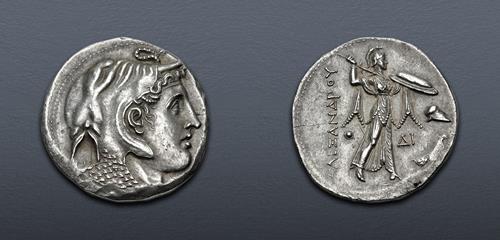|
PTOLEMAIC KINGS of EGYPT. Ptolemy I Soter. As satrap, 323-305/4 BC or king, 305/4-282 BC. AR Tetradrachm (27.5mm, 15.75 g, 1h). Ptolemaic standard. In the name of Alexander III of Macedon. Alexandreia mint. Struck circa 306-300 BC. Diademed head of the deified Alexander right, wearing elephant skin, aegis around neck / AΛEΞANΔPOY, Athena Alkidemos advancing right, brandishing spear in right hand and wearing shield on extended left arm; small round shield to inner left; to right, helmet, ΔI, and eagle standing right on thunderbolt. CPE 74; Svoronos 176; Zervos Issue 32 (dies 532/a – this coin referenced); SNG Copenhagen –; Künker 111, lot 6343 = Banque Populaire du Nord FPL April 1987, no. 258 (same dies). Attractive old collection tone, hairline flan crack, minor area of flat strike at edge on reverse. EF. Extremely rare issue, one of only six noted by Zervos, with one additional in CoinArchives; five are in museum collections (Alexandria [Graeco-Roman Museum], Berlin [Staatliche Museen, 2 coins], New York [ANS], and Paris [BN]).
Ex Wild Rose Collection; Triton XXII (8 January 2019), lot 403; Santamaria (24 January 1938), lot A168; Richard Cartwright Collection (Münzhandlung Basel 4, 1 October 1935), lot 949. Lot also includes two old collection tickets.
Ptolemy I Soter, the son of the Macedonian nobleman Lagus, was a friend and intimate of Alexander III the Great from boyhood and accompanied him on his great career of conquest, from 333-323 BC. Upon Alexander’s death in 323 BC, Ptolemy was granted the prized satrapy of Egypt, the richest of the formerly Persian provinces. Alone among the Diadochi (”successors”), he was largely content with his sphere of influence and did not risk everything to become master of all Alexander’s conquests. However, he was not above using the great conqueror’s image and reputation to secure his own position. In late 322 BC, he hijacked Alexander’s funeral cortege as it was proceeding back to Macedon and had his embalmed corpse formally interred at Memphis in Egypt. The brazen act caused Perdikkas, regent of the empire, to declare war on Ptolemy and launch a full-scale attack. But Ptolemy cleverly stymied the advance of Perdikkas at the Nile and blockaded his army, leading to a revolt and the regent’s assassination. His position strengthened, Ptolemy went on to rule Egypt for nearly 40 years and founded a dynasty that lasted three centuries.
Ptolemy’s early coinage was patterned on Alexander the Great’s ubiquitous Herakles coinage, and was minted at the royal residence of Memphis and subject cities in the Levant. Circa 320 BC, the Memphis mint introduced a new obverse type with the head of the deified Alexander wearing an elaborate headdress made from the skin of an Indian elephant, celebrating his victories in India. Catherine Lorber also notes the small, snake-like trunk on the headdress resembles the uraeus worn by Egyptian Pharaohs, while the ram’s horn of the Greco-Egyptian god Ammon is shown at Alexander’s temple, poking out from underneath the headdress. Four years later came a new reverse depicting Athena Promachos (”Athena who fights on the front line”) in a fighting stance; the new type likely coincided with the relocation of the main mint from Memphis to the new capital of Alexandreia. Though Ptolemy was effectively king in all but name, all of these issues carried the name of Alexander, preserving the fiction of a unified Macedonian empire. The initial issues were on the Attic standard of a tetradrachm weighing about 17 grams, but in 311 BC this was reduced to a new Ptolemaic standard of about 15.7 grams, perhaps as an emergency measure. If so, Ptolemy soon realized the financial advantages to be gained by reducing the weight of the coinage and making Egypt a closed economic sphere. In 305 BC, Ptolemy pronounced himself king (Basileos) and struck gold coins with his own portrait; silver tetradrachms of the elephant skin-type were still struck until 294 BC, when a new portrait type of further reduced weight was introduced.
The final winners of all CNG Feature Auction 129 lots will be determined during the live online sale that will be held on 13-14 May 2025. This lot is in Session One, which will begin 13 May at 9 AM ET.
Winning bids are subject to a 22.5% buyer's fee for bids placed on this website and 25% for all others.
We recognize that our users may have various Internet Browsers and Operating Systems. We like our visitors to have the best possible experience when using our bidding platform. However, we do recognize that it is impossible to develop applications that work identically, efficiently and effectively on all web browsers. The CNG bidding platform supports the latest stable major version and stable previous version of Chrome and Firefox.
|
